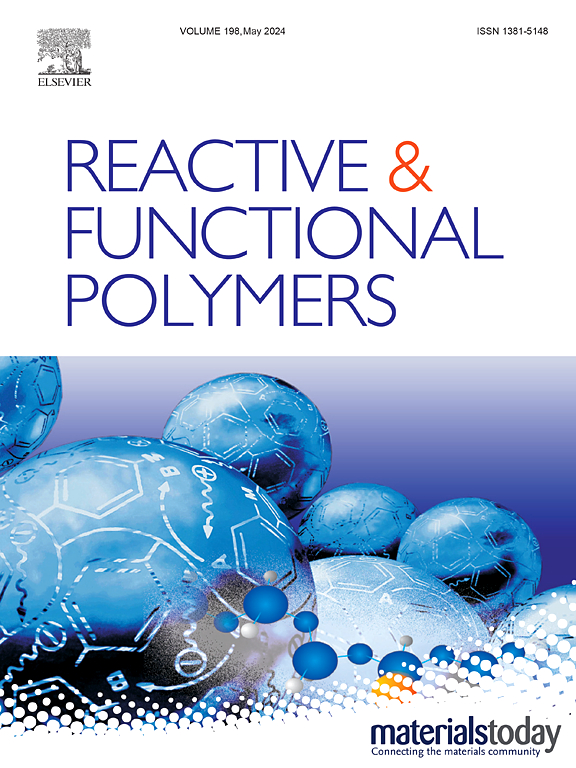Organocatalyzed ring-opening polymerization of proline-based lactones for poly(amino ester)s and cationic polymers with antibacterial activity
IF 4.5
3区 工程技术
Q1 CHEMISTRY, APPLIED
引用次数: 0
Abstract
Poly(amino ester)s (PAEs) are widely employed in diverse applications, particularly biomedicine, owing to their tunable functionality via amine group modification and the inherent biodegradability and biocompatibility of their polyester chains. Herein, we reported (thio)urea/base-catalyzed ring-opening polymerization of proline-based lactones for well-defined poly(amino ester)s. A series of (thio)ureas and organic bases were synthesized and combined to form various binary organocatalysts to explore the structure-activity relationships. Monomer conversion up to 95 % was achieved within 5 min. Kinetics studies and chain extension experiments confirmed the living/controlled nature of ROP. Four well-defined PAEs with high molecular weights (3150–51,340 g mol−1) and narrow dispersity (Đ < 1.29) were produced. The resultant PAEs showed high thermal stability (Td,5% = 224–350 °C) and Tm (189–244 °C). Furthermore, seven cationic random or block copolymers were synthesized through ring-opening copolymerization, followed by deprotection reaction. The effect of copolymer composition on the self-assembly behavior was investigated by DLS and TEM. Cationic random copolymers with high hydrophobic content demonstrated strong antimicrobial activity against E. coli, while those with high hydrophilic content were more active against S. aureus. This work would provide valuable insights into poly(amino ester)s and cationic polymers with tailored antimicrobial activity.

脯氨酸基内酯的有机催化开环聚合制备具有抗菌活性的聚氨基酯和阳离子聚合物
聚氨基酯(PAEs)广泛应用于各种领域,特别是生物医学领域,因为它们通过胺基修饰具有可调节的功能,并且它们的聚酯链具有固有的生物降解性和生物相容性。在此,我们报道了(硫)尿素/碱催化的脯氨酸基内酯开环聚合反应。合成了一系列(硫)脲和有机碱并组合成多种二元有机催化剂,探索其构效关系。单体转化率在5分钟内达到95%。动力学研究和链延伸实验证实了ROP的活性/可控性。四种定义明确的PAEs具有高分子量(3150-51,340 g mol−1)和窄分散性(Đ <;1.29)。合成的PAEs具有较高的热稳定性(Td,5% = 224-350℃)和Tm(189-244℃)。通过开环共聚和脱保护反应,合成了7种阳离子无规或嵌段共聚物。通过DLS和TEM研究了共聚物组成对自组装行为的影响。疏水含量高的阳离子无规共聚物对大肠杆菌的抑菌活性较强,亲水含量高的阳离子无规共聚物对金黄色葡萄球菌的抑菌活性较强。这项工作将为具有定制抗菌活性的聚氨基酯和阳离子聚合物提供有价值的见解。
本文章由计算机程序翻译,如有差异,请以英文原文为准。
求助全文
约1分钟内获得全文
求助全文
来源期刊

Reactive & Functional Polymers
工程技术-高分子科学
CiteScore
8.90
自引率
5.90%
发文量
259
审稿时长
27 days
期刊介绍:
Reactive & Functional Polymers provides a forum to disseminate original ideas, concepts and developments in the science and technology of polymers with functional groups, which impart specific chemical reactivity or physical, chemical, structural, biological, and pharmacological functionality. The scope covers organic polymers, acting for instance as reagents, catalysts, templates, ion-exchangers, selective sorbents, chelating or antimicrobial agents, drug carriers, sensors, membranes, and hydrogels. This also includes reactive cross-linkable prepolymers and high-performance thermosetting polymers, natural or degradable polymers, conducting polymers, and porous polymers.
Original research articles must contain thorough molecular and material characterization data on synthesis of the above polymers in combination with their applications. Applications include but are not limited to catalysis, water or effluent treatment, separations and recovery, electronics and information storage, energy conversion, encapsulation, or adhesion.
 求助内容:
求助内容: 应助结果提醒方式:
应助结果提醒方式:


